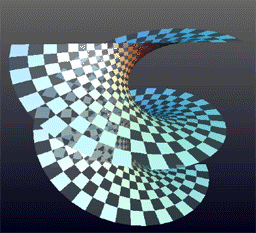Associate family

In differential geometry, the associate family (or Bonnet family) of a minimal surface is a one-parameter family of minimal surfaces which share the same Weierstrass data. That is, if the surface has the representation
the family is described by
For θ = π/2 the surface is called the conjugate of the θ = 0 surface.[1]
The transformation can be viewed as locally rotating the principal curvature directions. The surface normals of a point with a fixed ζ remains unchanged as θ changes; the point itself moves along an ellipse.
Some examples of associate surface families are: the catenoid and helicoid family, the Schwarz P, Schwarz D and gyroid family, and the Scherk's first and second surface family. The Enneper surface is conjugate to itself: it is left invariant as θ changes.
Conjugate surfaces have the property that any straight line on a surface maps to a planar geodesic on its conjugate surface and vice versa. If a patch of one surface is bounded by a straight line, then the conjugate patch is bounded by a planar symmetry line. This is useful for constructing minimal surfaces by going to the conjugate space: being bound by planes is equivalent to being bound by a polygon.[2]
There are counterparts to the associate families of minimal surfaces in higher-dimensional spaces and manifolds.[3]
References[]
- ^ Matthias Weber, Classical Minimal Surfaces in Euclidean Space by Examples, in Global Theory of Minimal Surfaces: Proceedings of the Clay Mathematics Institute 2001 Summer School, Mathematical Sciences Research Institute, Berkeley, California, June 25–July 27, 2001. American Mathematical Soc., 2005 [1]
- ^ Hermann Karcher, Konrad Polthier, "Construction of Triply Periodic Minimal Surfaces", Phil. Trans. R. Soc. Lond. A 16 September 1996 vol. 354 no. 1715 2077–2104 [2]
- ^ J.-H. Eschenburg, The Associated Family, Matematica Contemporanea, Vol 31, 1–12 2006 [3]
- Differential geometry
- Minimal surfaces

![x_{k}(\zeta ,\theta )=\Re \left\{e^{{i\theta }}\int _{0}^{\zeta }\varphi _{{k}}(z)\,dz\right\}+c_{k},\qquad \theta \in [0,2\pi ]](https://wikimedia.org/api/rest_v1/media/math/render/svg/8412d52c5c7faf8f45b10c51e0b334f11ebf2ce1)
